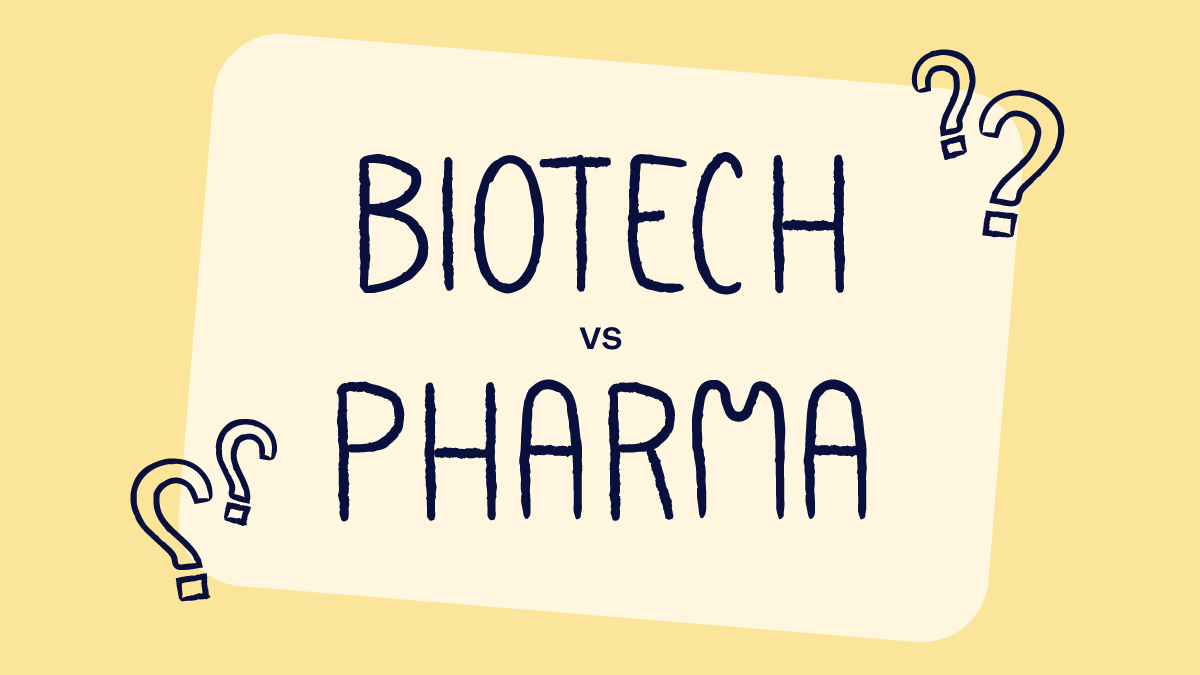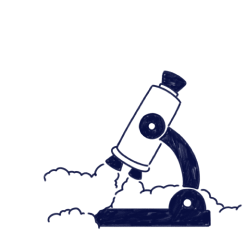
From Lab bench to market: Navigating biotech and pharma
Ever wondered what really sets biotech apart from pharma? They're often lumped together, but these two powerhouses of human health take radically different routes to get from concept to cure. From living cells to chemical synthesis, and from lean startups to pharma giants—let’s unpack what makes them unique (and surprisingly similar) in their mission to improve lives.
Biotechnology (biotech) and pharmaceutical (pharma) companies both fall under the vast umbrella of the “life sciences” industry, which encompasses businesses and organizations concerned with the study of living things, including people, animals and plants. While the scope of the life sciences industry is pretty broad, the general aim is to improve the health and well-being of living things.
As part of this, biotech and pharma companies both play an important role in advancing healthcare for humans, although biotech companies also play important roles in many other fields, too, not just healthcare.
As such, any company that researches, develops or manufactures biotechnologies or medicines for use in human healthcare will be subject to certain quality standards and scrutinized by regulatory bodies, such as the FDA and EMA.
In this post, we’ll explain what biotech and pharma companies are in the context of human healthcare, how they’re similar, how they’re different, and provide 3 key takeaways for you to bear in mind, as a QA professional working in the life sciences industry.
What is a biotech company?
As you may have guessed from their full name, biotechnology companies use living organisms or biological systems to develop products and technologies. The industry is known for being highly innovative, and companies tend to be specialized and focused on specific areas of research and development.
Many biotech companies focus on human healthcare, but other areas of focus for biotech companies include agriculture and environmental management, with applications ranging from genetically modified crops to bioenergy production from organic waste.
Biotech companies that are focused on improving human health may also be referred to as “biopharma” companies by some people in the industry. They use biological processes and organisms to advance the development of vaccines, diagnostic tools, treatments for genetic diseases and biologic therapies (biologics), to name but a few. Biologics are large-molecule drugs, like proteins or hormones, that are derived from living organisms.
For example, a famous example of a biologic is the hormone insulin, which can be produced by inserting the human insulin gene into bacteria and then used to treat type 1 diabetes. Other famous examples of biologics include mRNA vaccines used in the prevention of COVID-19.
What is a pharmaceutical company?
Pharma companies focus on developing and producing small-molecule drugs and medicines for human healthcare (although some also produce veterinary medicines, too). They do this through chemical synthesis, without the use of living organisms. They’re seen as the “powerhouses” of drug production and specialize in the “traditional” development, production and distribution of small-molecule drugs.
For example, a well-known small-molecule drug is aspirin, which inhibits the production of enzymes involved in pain, inflammation and fever.
Blended companies
In reality, many big organizations most people might think of as being pharma companies are actually combined biotech and pharma organizations. It’s really common for cash-rich pharma companies to buy up small, innovative biotech firms if they notice a promising new biotechnology in development, especially if it could help them deliver on their mission to drive change in certain therapeutic areas.
Recommended learning: Curious how quality fits into all this? Discover the critical role a Quality Management System plays in pharmaceutical companies and why it’s more than just a box-ticking exercise. Read our full QMS in Pharma guide.
Biotech vs pharma—what’s the similarities?
There are many similarities between biotech and pharma companies that work on improving human health:
- Objectives: During product development stages, the objectives of pharma and biotech companies are to identify unmet medical needs and then meet those needs through the development and production of new therapies.
- Development pipeline: The development “pipeline” for both small-molecule drugs vs. biotechnological therapies is structured in similar phases, starting with research and development (R&D), followed by clinical testing, regulatory approval (a key milestone when a drug or biotech product becomes authorized for clinical use by a regulatory body such as the FDA) and then commercialization.
- Highly regulated: From clinical testing until the end of manufacturing, strict regulatory requirements are in place for both pharma and biotech companies, mandated by regulatory bodies like the FDA in the United States or EMA in Europe. While these differ for pharma vs. biotech, they contain similar aspects, such as stringent quality control processes during.
- Evidence for approval: Both biotech and pharma companies need to collect a high level of safety and efficacy data on investigational therapies collected during clinical trials. This is then presented to regulators such as the FDA. Before a product can obtain marketing approval, therapies need to have been proven safe and effective for use in a specified indication, although expedited approval pathways do exist for some potentially life-saving treatments.
- Mandated quality controls: Biotech and pharma companies both need dedicated personnel who are well-versed in Quality Assurance (QA), Compliance and Regulatory obligations to ensure that they meet their complex regulatory and quality obligations. Custom-built tools and technologies can also streamline workflows for regulatory compliance and quality management and can greatly benefit both biotech and pharma QA and compliance teams.
Biotech vs pharma—what’s the difference?
Same destination, different paths. Similarly, there are a number of differences between biotech and pharma companies:
- Size and structure: Biotechs tend to be smaller, research-centric organizations, with less resources and a higher risk of “going bust” without making a breakthrough, whereas pharma companies are often larger, integrated corporations with global operations and busy pipelines of drugs in development and products already on the market.
- Regulatory considerations: Working with living organisms adds additional regulatory requirements, meaning biotech companies often face longer and more costly drug development processes than pharma. That said, pharma companies also face a development pipeline of several years and many millions of dollars in costs just to develop a single drug.
- FDA approval pathways: In the United States, pharma products submit a new drug application (NDA) to the FDA via the Center for Drug Evaluation and Research (CDER), whereas biotech products such as biologics and cell and gene therapies will submit a Biologics License Application (BLA) to the FDA via the Center for Biologics Evaluations and Research (CBER).
- Manufacturing and quality considerations: Manufacturing and logistics can be exceptionally complex for biotech companies. Additional transport and storage requirements such as temperature and other environmental factors need to be carefully controlled when working with living organisms.
- R&D focus: Biotech companies are often focused on R&D and may be dependent on securing funding for their research. Such companies may join an incubator or accelerator to advance more quickly, which can provide access to equipment, tools and expertise otherwise unavailable. Pharma companies, on the other hand, tend to have more resources available for all stages of drug development, including R&D. They often use an automated high-throughput screening method to test hundreds of compounds against a biological target.
- Level of risk: Between 70% and 90% of biotech startups fail because often, the race is to discover a new drug lead and reach proof of concept before funding runs out. Whereas pharma companies typically have enough resources available to sink the cost of the (many!) failed lines of research and continue on their quest to develop new treatments.
- Applications: Biotech companies are often at the cutting-edge of science, developing therapies for genetic disorders, cancers and as yet untreated conditions using a vast array of innovative techniques and technologies such as gene editing or cell culture processes. Pharma, on the other hand, has a broader range of applications and has been developing drugs “traditionally” to fill a host of unmet medical needs for many decades.
- Growth of industry: Currently, the pharma industry is larger than the biotech industry, estimated at USD 1.6 trillion compared with USD 1.54 trillion. But the biotech industry is growing faster than the pharma industry, with exciting emerging therapies like cell and gene therapies and greater demand for innovative treatments fueling the growth.
Biotech vs pharma: Side-by-side comparison chart

Key takeaways
- Biotech companies use biological processes and organisms to advance the development of vaccines, diagnostic tools, treatments for genetic diseases and biologic therapies (large-molecule drugs, like proteins or enzymes), whereas pharma companies produce small-molecule drugs by “traditional” chemical synthesis.
- Both biotech and pharma companies are highly regulated and must comply with strict regulatory requirements enforced by regulators such as the FDA in the United States. These requirements include stringent quality control during manufacturing, transport and storage.
- To be approved for use in the United States, both biotech and pharma products need to obtain approval from the FDA. The approval pathways are different, but all new drug applications need to provide a high standard of evidence from preclinical and clinical trail to show that new drugs are both safe and effective.
How can an eQMS take your biotech or pharma company to new heights
Many biotech companies or smaller pharma companies are still using either paper-based or spreadsheet-based quality management processes. But as small companies expand, so does the complexity of their quality control obligations, and a manual quality management system (QMS) can become inefficient and risky.
Investing in an eQMS system can reduce costs, timelines and risks of noncompliance. Just take a look at the case of Jorge, who oversees document management at Proteos Biotech.
“Before using Scilife, we stored all our documents in paper archives. Retrieving specific SOPs during audits was time-consuming, and we were constantly running out of storage space.”
—Jorge, Proteos Biotech
The company transitioned from a paper-based QMS to Scilife’s eQMS, with integrated modules covering Corrective and Preventive Actions (CAPA) management, deviations, and change control into their operations. These included document control and training modules.
“The system is very user-friendly, and the dashboard provides a clear overview of tasks and pending actions, making our daily operations more efficient.”
—Jorge, Proteos Biotech
Recommended learning: What separates a good eQMS from a great one? From document control to risk management, discover the core elements that make an eQMS effective—not just compliant. Get the inside scoop on what truly matters in our latest guide.
Conclusion
Still using paper or spreadsheets? It might be time to switch. Whether you’re a fast-growing biotech startup or an established pharma team, the right eQMS can streamline your operations, simplify audits, and give your team room to breathe.
Scilife’s electronic QMS is designed specifically for life sciences companies—helping both biotech and pharma organizations reduce compliance risks, speed up processes, and scale efficiently.
See how Scilife empowers life sciences companies to manage quality smarter—not harder. Explore Scilife’s eQMS solution here.






